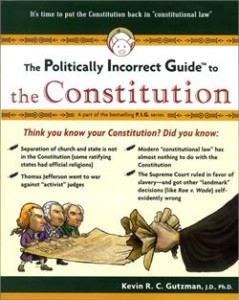The schoolboy version of the American system of government centers on the three-branch structure of the Federal Government established by the ratification of the Constitution in 1788. Integral to that structure are a system of checks and balances among those three branches and the division of powers between the Federal Government and the states. The Tenth Amendment makes that federalism principle explicit.
The dirty little secrets, however, are that the division of powers disappeared long ago, and the checks and balances do not work. Instead of a decentralized, republican system in which the Federal Government bears responsibility for only a few issues, then, Americans now groan under an unlimited central government whose taxing, spending, borrowing, and printing seemingly know no limits either of law or of sense.
To read through this tome is to be struck by the unalloyed banality of both Stevens’ writing and his mind. Stevens spent thirty-four years on the Court, and yet the 282 pages in his book include a 32-page Appendix reproducing the Constitution, the signatures affixed to the Constitution, and the amendments, two pages of acknowledgements, and several blank pages. In addition, he gives thirty pages over to an extremely shallow account of the history of the Supreme Court up to the middle of the twentieth century.In light of their distended significance, Supreme Court justices now occasionally bless the rest of us with their ruminations. The latest specimen of the genre is John Stevens’ Five Chiefs: A Supreme Court Memoir.
For example, Stevens’ account of Chief Justice Roger B. Taney’s tenure as chief justice is notably brief. Its one paragraph merely summarizes the Court’s outrageous decision in Dred Scott v. Sandford (1857) and says that, “The only good thing that can be said about that case is that Abraham Lincoln’s criticism of it in his famous debates with Stephen Douglas received nationwide attention and helped get him elected president.” (p. 20)An impressive intellect might have turned the excursion through the Court’s early history to good effect. Stevens, on the other hand, seems not to recognize the ways in which events he glosses over laid the groundwork for his own career.
Yet, Stevens actually based much of his performance as an associate justice on the foundation of Dred Scott. It was after all in Dred Scott that the Court invented the idea of what scholars and judges alike now call “substantive due process.” That idea is that the Fifth Amendment’s statement that, “nor shall any person … be deprived of life, liberty, or property, without due process of law” did more than guarantee that before one could be punished, he must first be afforded all of the incidents of the traditional Anglo-American adversarial process.
No, the Fifth Amendment’s Due Process Clause was used in Dred Scott as an empty vessel into which seven entirely partisan Democratic justices could pour their desired partisan outcome: a holding that Congress could not bar slavery from the western territories. Far from merely procedural, as it seemed to be (and had always been thought to be), the Due Process Clause was substantive.
When in the 1860s Congress came to draft the Fourteenth Amendment, it inserted a clause nearly identical to the Fifth Amendment’s Due Process Clause, this time applying the requirement to the states. Beginning in the early 20th century, federal judges used this provision as an empty vessel into which they could pour all of their favorite policy outcomes, this time making them enforceable against the states.
Stevens makes clear what he does not mean: that the outcome is consistent with the intention of the people in adopting a particular legal or constitutional provision. He provides only the assertion that one must not be guided by any such intention.Stevens in the slim portion of the book on his own career trumpets various rights-creating lines of the Court’s recent product, such as the cases in which the justices invented various sexual rights enforceable against the states, various religious rights enforceable against the states, etc. He calls some of these outcomes “correct” without ever saying how one can know which outcome is correct.
 Here we find the fundamental theoretical shortcoming of the current American regime: that no one ever consented to it. As I showed in The Politically Incorrect Guide to the Constitution, federal judges long ago abandoned the notion that constitutional interpretation was about, well, interpretation. Instead, Taney-like, they use constitutional cases – and, when it comes to enforcing made-up individual rights against state governments, Taney’s Dred Scott doctrine of substantive due process – as opportunities to impose their will.
Here we find the fundamental theoretical shortcoming of the current American regime: that no one ever consented to it. As I showed in The Politically Incorrect Guide to the Constitution, federal judges long ago abandoned the notion that constitutional interpretation was about, well, interpretation. Instead, Taney-like, they use constitutional cases – and, when it comes to enforcing made-up individual rights against state governments, Taney’s Dred Scott doctrine of substantive due process – as opportunities to impose their will.
This problem was uniquely grievous in the case of Justice Stevens. As the sole Supreme Court appointee of President Gerald Ford, Stevens was the sole justice appointed by a man who had never been elected either president or vice president. Even if one accepted the legitimacy of substantive due process as a way for people indirectly elected to enforce their superior wisdom on the rest of us, then, it would still be hard to see how Ford’s appointment of Stevens could justify wide-ranging legislative behavior by Stevens.
Stevens blithely accepts that the Supreme Court is a kind of super-legislature. Indeed, Five Chiefs gives not the slightest indication that Stevens has ever considered this matter. One might wonder whether he has thought about the Constitution much at all. For example, I am certain that every student in my recently concluded undergraduate course in American Constitutional History knows that the Bill of Rights is the first ten amendments to the US Constitution. Stevens, on the other hand, refers to “the first eight amendments to the Constitution, commonly described as the Bill of Rights.” (p. 19)
No, this doubtless is not a typographical or editorial mistake. Rather, it reflects the Hamiltonian approach to federal power taken by virtually all of our ruling elite today. As James Madison and his fellows explained the Constitution, it was to create a few islets of federal power in a sea of liberty. The Bill of Rights’ purpose was to ensure that the limits on the Federal Government’s power were respected, and thus to help preserve the principle of subsidiarity so integral to the Constitution’s original structure.
Thus, the Ninth Amendment said that the list of rights earlier in the Constitution was not exclusive, and the Tenth said that all powers not given to the Federal Government by the Constitution or denied by it to the states were reserved to the states or the people. Clearly, neither of these amendments serves the purpose of Stevens and the like, whose goal is to impose their will regardless of petty issues like popular consent.
They have ignored the Ninth and Tenth Amendments for so long that, like a Trotskyite of old, those amendments no longer appear in the official photos. Now, the Constitution as they understand it stands for a few small islets of liberty in a sea of power.
 Stevens’ ideas thus reflect not some well-considered jurisprudential perspective, but the Common Wisdom of our Betters. Rather than burdening readers with discussion of such matters, Stevens devotes more than two pages of his book – a memoir of thirty-five years on the Supreme Court – to an explanation of the placement of the conference table in the room where justices meet to discuss pending cases. (pp. 212-14) Utter inanity.
Stevens’ ideas thus reflect not some well-considered jurisprudential perspective, but the Common Wisdom of our Betters. Rather than burdening readers with discussion of such matters, Stevens devotes more than two pages of his book – a memoir of thirty-five years on the Supreme Court – to an explanation of the placement of the conference table in the room where justices meet to discuss pending cases. (pp. 212-14) Utter inanity.
Numerous journalists have spilled lakes of ink describing absurdly low-brow discussion in American legislative bodies. John Paul Stevens’ memoir shows why we should not assume that decision-making by unelected, unaccountable, politically connected lawyers meeting in secret in Washington is a superior alternative to parliamentary politics. If you have a low opinion of American legislators, you ought to favor less government, not government by judiciary. Come to think of it, that was the Constitution’s bias as well. At least, as it was originally understood.
Copyright © 2011 by LewRockwell.com. Permission to reprint in whole or in part is gladly granted, provided full credit is given.
- A Jeffersonian American Patriot is a State Patriot - July 2, 2018
- A Jeffersonian American Patriot is a State Patriot - July 5, 2017
- Bill of Rights Day: A Day of Mourning - December 14, 2015
